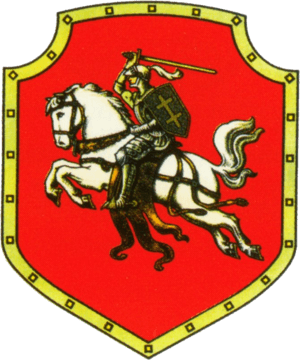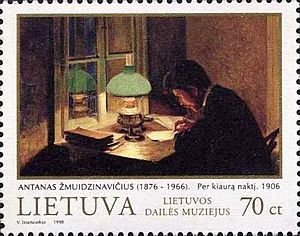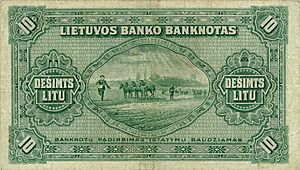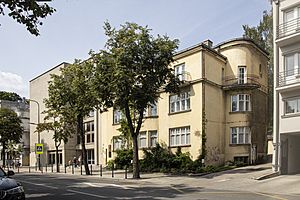Antanas Žmuidzinavičius facts for kids
Quick facts for kids
Antanas Žmuidzinavičius
|
|
|---|---|

Žmuidzinavičius in Lithuania Album (1921)
|
|
| Born | 31 October 1876 Seirijai, Congress Poland
|
| Died | 9 August 1966 (aged 89) Kaunas, Lithuanian SSR
|
| Resting place | Petrašiūnai Cemetery |
| Nationality | Lithuanian |
| Alma mater | Veiveriai Teachers' Seminary Académie Colarossi Académie Vitti |
| Board member of | Vilnius Art Society Lithuanian Art Society |
Antanas Žmuidzinavičius (born October 31, 1876 – died August 9, 1966) was a famous Lithuanian painter and art collector. He is known for his beautiful landscape paintings and for helping to design the modern flag of Lithuania. He also collected many interesting items, including a large collection of devil figurines!
Žmuidzinavičius studied art in Warsaw and Paris. When he returned to Lithuania in 1906, he helped start the First Exhibition of Lithuanian Art and the Lithuanian Art Society. He also taught art for many years and was recognized as a People's Artist of the Soviet Union.
Contents
Biography
Early Life and Education
Antanas Žmuidzinavičius was born in 1876 in Seirijai, a town that was part of Congress Poland at the time. When he was very young, his family moved to a farm in Balkūnai. His father had been involved in the Uprising of 1863. Antanas was one of five children who grew up to be adults.
From 1890 to 1894, he studied at the Veiveriai Teachers' Seminary. After graduating, he worked as a teacher in Polish villages. During this time, he started drawing and writing poetry. In 1899, he moved to Warsaw and continued teaching. He also took evening art classes and private lessons to improve his painting skills. His artworks were first shown in galleries in 1902 and 1904. In Warsaw, he met other Lithuanian artists like Mikalojus Konstantinas Čiurlionis.
In 1904, Žmuidzinavičius went to Paris to study art further. He attended famous art schools like the Académie Colarossi and Académie Vitti. He also met his future wife, Marija Putvinskaitė, who was studying to be a dentist. They got married in 1909.
Returning to Lithuania
In 1906, Žmuidzinavičius came back to Vilnius, Lithuania. He played a big role in organizing the very first exhibition of Lithuanian art. He also became the chairman of the Lithuanian Art Society, which helped Lithuanian artists. In 1908, he created the Vilnius Art Society, which brought together artists from different backgrounds, including Polish, Russian, and Jewish artists.
Žmuidzinavičius loved to travel. In 1908, he toured Western Europe, visiting cities like Munich and Rome. He also traveled to the United States, where he gave talks about Lithuanian art and history. He even helped design backdrops for Lithuanian theaters in Chicago.
After returning, he worked hard to collect and display the artworks of his friend, Mikalojus Konstantinas Čiurlionis, who sadly passed away in 1911. In 1912, Žmuidzinavičius studied how to paint frescos in Hamburg. Just before World War I, in 1914, he traveled to the White Sea and painted arctic landscapes.
During and After the Wars
During World War I, Žmuidzinavičius continued to teach. He helped organize the Vilnius Conference in 1917, which was an important meeting for Lithuania's future. He also worked to protect artworks in Vilnius when the Soviets took control of the city in 1918.
From 1919 onwards, he mostly lived and worked in Kaunas. He supported the Lithuanian War of Independence and was one of the people who started the Lithuanian Riflemen's Union. He even helped recruit soldiers for the Lithuanian Army. He was captured by Polish forces once but managed to escape.
Žmuidzinavičius was very dedicated to creating a museum for Čiurlionis's works. In 1921, he also helped set up the Vytautas the Great War Museum. He traveled to the United States again to raise money for the Lithuanian Riflemen. He gave many talks and organized art exhibitions there.
From 1926 to 1953, Žmuidzinavičius taught drawing at the Kaunas Art School. He also led the Lithuanian Riflemen's Union and edited its magazine, Trimitas, for a few years.
After World War II, Žmuidzinavičius continued his work. He was recognized for his artistic achievements by the Soviet government. He became a professor and taught at the Kaunas Polytechnic Institute until 1966. He also became a member of the Academy of Arts of the Soviet Union.
Antanas Žmuidzinavičius passed away in Kaunas in 1966 and was buried in the Petrašiūnai Cemetery.
Works
Paintings
Žmuidzinavičius created over 2,000 artworks. Most of them were oil paintings of landscapes. He also painted portraits of famous people, scenes from everyday life, and religious images. His landscape paintings often show beautiful, peaceful nature scenes that make you feel a sense of longing. He used soft, warm, and earthy colors. His art showed his love and pride for his home country.
His paintings often featured typical Lithuanian landscapes. These included the shores of the Neman River, the sandy dunes of the Baltic Sea, the hills of Samogitia, and the forests of Dzūkija. He also painted cozy, quiet spots in nature, like lonely trees. Žmuidzinavičius's art style combined elements of romanticism and realism. He preferred traditional art and did not use modern art styles.
His works are displayed in many museums, including the Lithuanian National Museum of Art and the Vytautas the Great War Museum. His paintings are also sometimes sold at art auctions. One of his most expensive paintings, Dzūkų kaimelis (Village of Dzūkai), was sold for 53,000 euros in 2013.
Design Work

Antanas Žmuidzinavičius helped design the modern Flag of Lithuania. He created a green-red flag that was used at the Vilnius Conference in 1917. However, people thought it was too dark. So, a yellow stripe was added. Žmuidzinavičius, along with Tadas Daugirdas and Jonas Basanavičius, worked together to create the final design. The yellow-green-red flag was approved in 1918 and is still used today.
He also designed a version of the coat of arms of Lithuania that was very popular between the two World Wars. His design showed the knight on horseback looking like it was flying.
Žmuidzinavičius also helped design Lithuanian money. In 1919, he made drafts for new banknotes. Later, in 1927, he was asked to design the 10 litas banknote. His design showed a Lithuanian village, based on a photo of his brother sowing grain.
Besides flags and money, Žmuidzinavičius designed 32 postage stamps. He also created the first hats and badges for the Lithuanian Army. He designed the emblem for the Lithuanian Riflemen's Union, which featured the Cross of Vytis inside a shield.
Collections
Žmuidzinavičius was a very enthusiastic collector. He collected many items related to Lithuanian art and culture. He especially loved collecting Lithuanian folk art, such as clay whistles, sashes, aprons, and wood carvings. He also collected paintings, sculptures, musical instruments, letters, and photos.
In 1961, Žmuidzinavičius gave all his collections to the M. K. Čiurlionis National Art Museum. His collection of devil figurines started with a devil given to him by his friend Juozas Tumas-Vaižgantas. This collection grew so large that it needed its own special building!
Publications
Žmuidzinavičius also wrote several books. He used the pen name Antanas Žemaitis. He published a collection of essays called Lietuvos keliais (On Lithuanian Roads) in 1921. He also published a book of poems called Gyvenimo takais (On Life's Paths) in 1930.
He wrote two books about his life and experiences. One was Priešui ir tėvynei (For the Enemy and the Homeland) in 1931, which was about his activities during the Lithuanian Wars of Independence. The other was Peletė ir gyvenimas (Palette and Life) in 1961, which shared stories about his life and art career.
Legacy
The Žmuidzinavičius Museum was opened in his former home in Kaunas in February 1966. This museum is part of the M. K. Čiurlionis National Art Museum. The house was built in 1928 and later expanded. It was one of 44 modernist buildings in Kaunas that received the European Heritage Label in 2015.
The museum shows how Žmuidzinavičius's home looked during his life. It displays his paintings, his collections, and other items related to him. When the museum first opened, it had about 260 devil statues. This collection grew a lot over time with donations from all over the world. In 1982, a new three-floor building was built just for the devils. This building is now known as the Devils' Museum and has over 3,000 devil-themed items from more than 70 countries!
The house where Žmuidzinavičius grew up in Balkūnai was also turned into a memorial museum in 1982 by his nephew. This museum shows restored furniture, photos, and paintings related to his family. The place where he was born in Seirijai is marked by a memorial stone. In 1986, a room-museum dedicated to him was opened at the high school in Seirijai, and the school was renamed in his honor in 1989.
Streets in several Lithuanian towns, including Kaunas, Alytus, and Seirijai, are named after Žmuidzinavičius.
Awards
Žmuidzinavičius received many awards for his contributions:
- 1928: Order of the Lithuanian Grand Duke Gediminas (3rd class)
- 1931: Riflemen's Star
- 1932: Order of the Three Stars
- 1936: Order of the Lithuanian Grand Duke Gediminas (2nd class)
- 1946: Honored Artist of the Lithuanian SSR
- 1954: People's Artist of the Lithuanian SSR
- 1957: People's Artist of the Soviet Union
Images for kids
See also
 In Spanish: Antanas Žmuidzinavičius para niños
In Spanish: Antanas Žmuidzinavičius para niños







